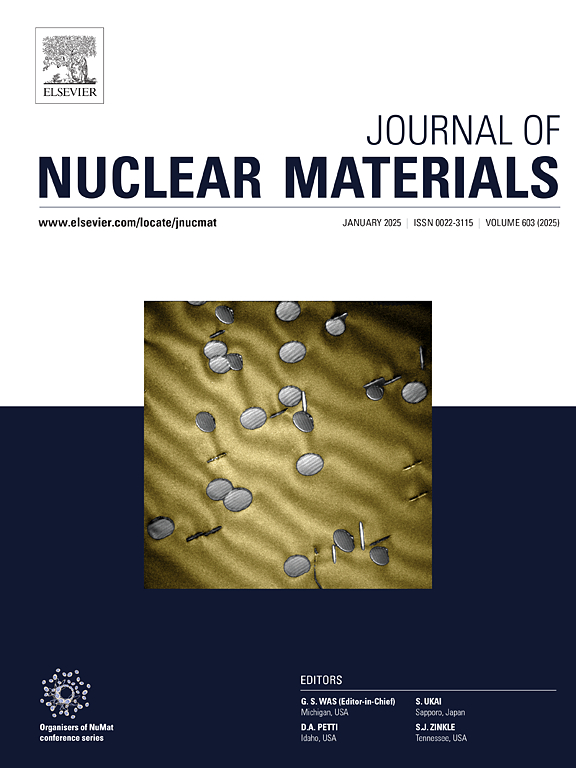模拟压水堆原生水316NG热影响区应力腐蚀裂纹扩展研究
IF 2.8
2区 工程技术
Q3 MATERIALS SCIENCE, MULTIDISCIPLINARY
引用次数: 0
摘要
在316NG的热影响区内,SCC的传播行为仍然没有得到充分的表征。本研究系统地评估了模拟压水堆原生水条件(325°C, 1200 mg/L B, 2 mg/L Li,氢化[30 mL (STP)/kg H₂]和氧化[0.5 ppm O₂]环境)下HAZ样品中SCC的生长情况,K = 30 MPa·m¹/²。在距离焊缝熔合线1mm和4mm处放置人工裂纹的致密拉伸(CT)试样,用于评估热影响区内SCC的生长情况,其中裂纹扩展区域扩展到距离内壁0.41-0.45的归一化距离。令人惊讶的是,在含氧和氢化水环境中,热影响区显示的裂纹扩展速率略低于或基本上与母金属的裂纹扩展速率相当。这表明SCC扩展区的压缩残余应力可以减缓通常由应变硬化引起的裂纹扩展加速(相对于母材硬度增加20%)。高分辨率透射电镜(HRTEM)分析表明,由于铁(Fe)沿晶界向裂纹尖端快速扩散以及铁和铬(Cr)在裂纹尖端的选择性氧化,镍(Ni)在裂纹尖端的晶界富集先于裂纹尖端。氧化膜形成明显的双层结构,外层为Fe₃O₄磁铁矿层,内层为Fe₂O₄尖晶石层。本文章由计算机程序翻译,如有差异,请以英文原文为准。
Insights into stress corrosion crack growth of 316NG heat-affected zone in simulated PWR primary water
The SCC propagation behavior in the HAZ of 316NG remains insufficiently characterized. This study systematically evaluates SCC growth in HAZ specimens under simulated PWR primary water conditions (325 °C, 1200 mg/L B, 2 mg/L Li, both hydrogenated [30 mL (STP)/kg H₂] and oxygenated [0.5 ppm O₂] environments) at constant K = 30 MPa·m¹/². Compact tension (CT) specimens that contained artificial cracks positioned 1 mm and 4 mm from the weld fusion line were employed to asses SCC growth in the HAZ, where the crack propagation region extended to a normalized distance of 0.41–0.45 from the inner wall surface. Surprisingly, the HAZ exhibited crack growth rates marginally lower than or essentially comparable to those of the parent metal in both oxygenated and hydrogenated water environments. This suggests that compressive residual stresses in the SCC propagation region may mitigate the crack growth acceleration typically induced by strain hardening (up to 20 % hardness increase relative to the parent metal). High-resolution transmission electron microscopy (HRTEM) analysis demonstrated nickel (Ni) enrichment at grain boundaries ahead of advancing crack tips, attributed to rapid iron (Fe) diffusion along grain boundaries toward the crack tip and selective oxidation of Fe and chromium (Cr) at the crack tip. The oxide film formed a distinct bilayer structure, with an outer Fe₃O₄ magnetite layer and an inner FeCr₂O₄ spinel layer.
求助全文
通过发布文献求助,成功后即可免费获取论文全文。
去求助
来源期刊

Journal of Nuclear Materials
工程技术-材料科学:综合
CiteScore
5.70
自引率
25.80%
发文量
601
审稿时长
63 days
期刊介绍:
The Journal of Nuclear Materials publishes high quality papers in materials research for nuclear applications, primarily fission reactors, fusion reactors, and similar environments including radiation areas of charged particle accelerators. Both original research and critical review papers covering experimental, theoretical, and computational aspects of either fundamental or applied nature are welcome.
The breadth of the field is such that a wide range of processes and properties in the field of materials science and engineering is of interest to the readership, spanning atom-scale processes, microstructures, thermodynamics, mechanical properties, physical properties, and corrosion, for example.
Topics covered by JNM
Fission reactor materials, including fuels, cladding, core structures, pressure vessels, coolant interactions with materials, moderator and control components, fission product behavior.
Materials aspects of the entire fuel cycle.
Materials aspects of the actinides and their compounds.
Performance of nuclear waste materials; materials aspects of the immobilization of wastes.
Fusion reactor materials, including first walls, blankets, insulators and magnets.
Neutron and charged particle radiation effects in materials, including defects, transmutations, microstructures, phase changes and macroscopic properties.
Interaction of plasmas, ion beams, electron beams and electromagnetic radiation with materials relevant to nuclear systems.
 求助内容:
求助内容: 应助结果提醒方式:
应助结果提醒方式:


